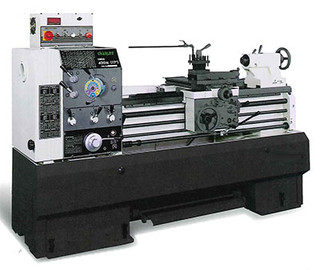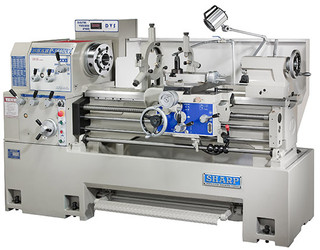- Joined
- Jun 12, 2014
- Messages
- 4,808
Typically the limitation to metal removal in a manual lathe of this size would be more the inert size and DOC, the other factor is that in order to get the speed range for a 2 speed or 3 speed VFD model lathe they will run the motor in the range of 20-180 or 200 Hz, above the base speed the torque will fall off in a non linear fashion but you gain the mechanical advantage, below the base speed the motor torque is flat but you loose the multiplication factor due to the gearing. Most VFD machines will compensate for this by using a larger motor, so in 14-16"swing models they typically will go with a 5 Hp, 17" is usually 7.5-10Hp. The additional 3rd gear range in the Sunmaster lathes mentioned goes a long way to covering the 200-600 RPM range where torque would fall off in a 2 speed. Above 600 RPM, the work diameter gets smaller and thus less applied torque at the radius of the cut is needed. There are cases where one can stall a VFD model, but typically it is due more to a cost cutting compromise in smaller lathes and mills, I would not expect those limitations in a light industrial lathe. It is all a trade-off, but if VFD system is designed properly, something else will break before one reaches the power limitations of the drive system.
I also find that when using a VFD for speed control I can dial in a more ideal cutting conditions dynamically when turning and boring/drilling, as I can adjust the speed until I get the chips coming off the way I want without chatter or vibration. Also when using my larger MT drills that there is an ideal speed range typically +/-10% for that size drill and the material/feed rate.
There are several nice features when you get into the 17" range of lathes mentioned, the larger spindle bore and also the mechanical stop system that kicks out the carriage feed. Controlled acceleration and braking is also a plus on the VFD models if the lathe is not equipped with a clutch system, but as the lathes get bigger so does everything else, which means increased tooling costs as well as needing assisting lifting devices for the chucks and for moving other parts of the lathe. I also indicated that the headstock width can be a factor, depending on the type of work being done.
I also find that when using a VFD for speed control I can dial in a more ideal cutting conditions dynamically when turning and boring/drilling, as I can adjust the speed until I get the chips coming off the way I want without chatter or vibration. Also when using my larger MT drills that there is an ideal speed range typically +/-10% for that size drill and the material/feed rate.
There are several nice features when you get into the 17" range of lathes mentioned, the larger spindle bore and also the mechanical stop system that kicks out the carriage feed. Controlled acceleration and braking is also a plus on the VFD models if the lathe is not equipped with a clutch system, but as the lathes get bigger so does everything else, which means increased tooling costs as well as needing assisting lifting devices for the chucks and for moving other parts of the lathe. I also indicated that the headstock width can be a factor, depending on the type of work being done.



